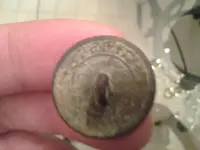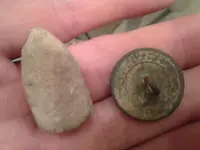Because so many newcomers ask for identification and time-dating of these brass 1-piece "flatbuttons," pardon me for just doing a cut-&-paste from one of my previous replies.
The backmark saying "GILT" is a Quality Rating used by British (and eventually, American) button manufacturing companies, which refers to the quality-level of the goldplating (gilt) or silverplating on these 1-piece brass buttons. A few of the many other examples are:
Standard Quality (often abbreviated as STANDd -- note the small letter d)
Extra Quality
Superior Quality
Superfine Quality
Fine Gilt
Double Gilt
Treble Gilt
Treble Plated (at that time, "Plated" referred only to silver, not gold)
Being a brass (not pewter) 1-piece button, with an indented-lettering (not raised-lettering) backmark, and dug in the US (not in Britain/UnitedKingdom or Canada) your button dates from approximately 1810 into the early-1830s. Note, if the backmark is written in raised lettering the button can date from as early as the 1790s.
Your 1-piece brass flatbutton is most probably British-made, because millions of them were imported here during that time-period, due to the fledging American button-making industry's inability to mass-produce enough to satisfy the demand for them from the clothing-making industry.






